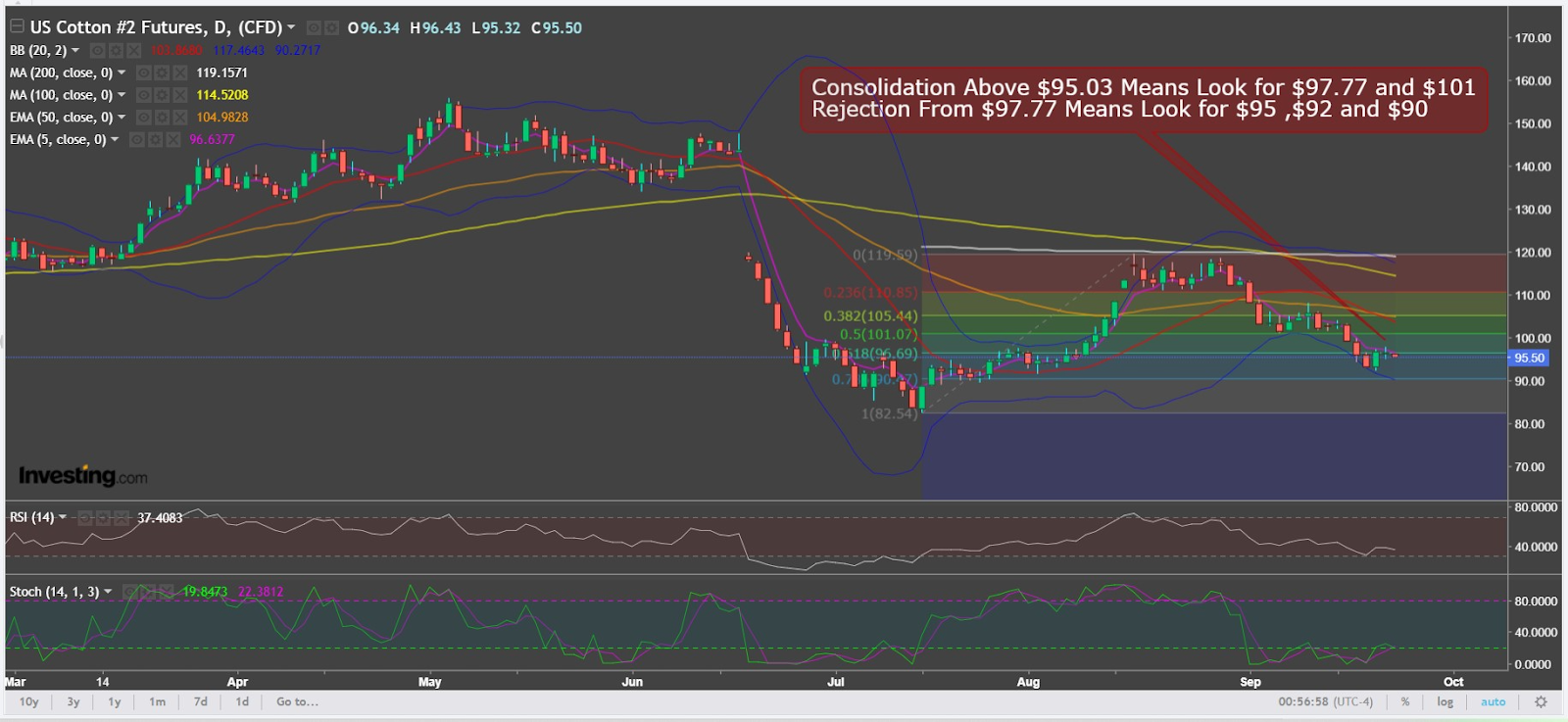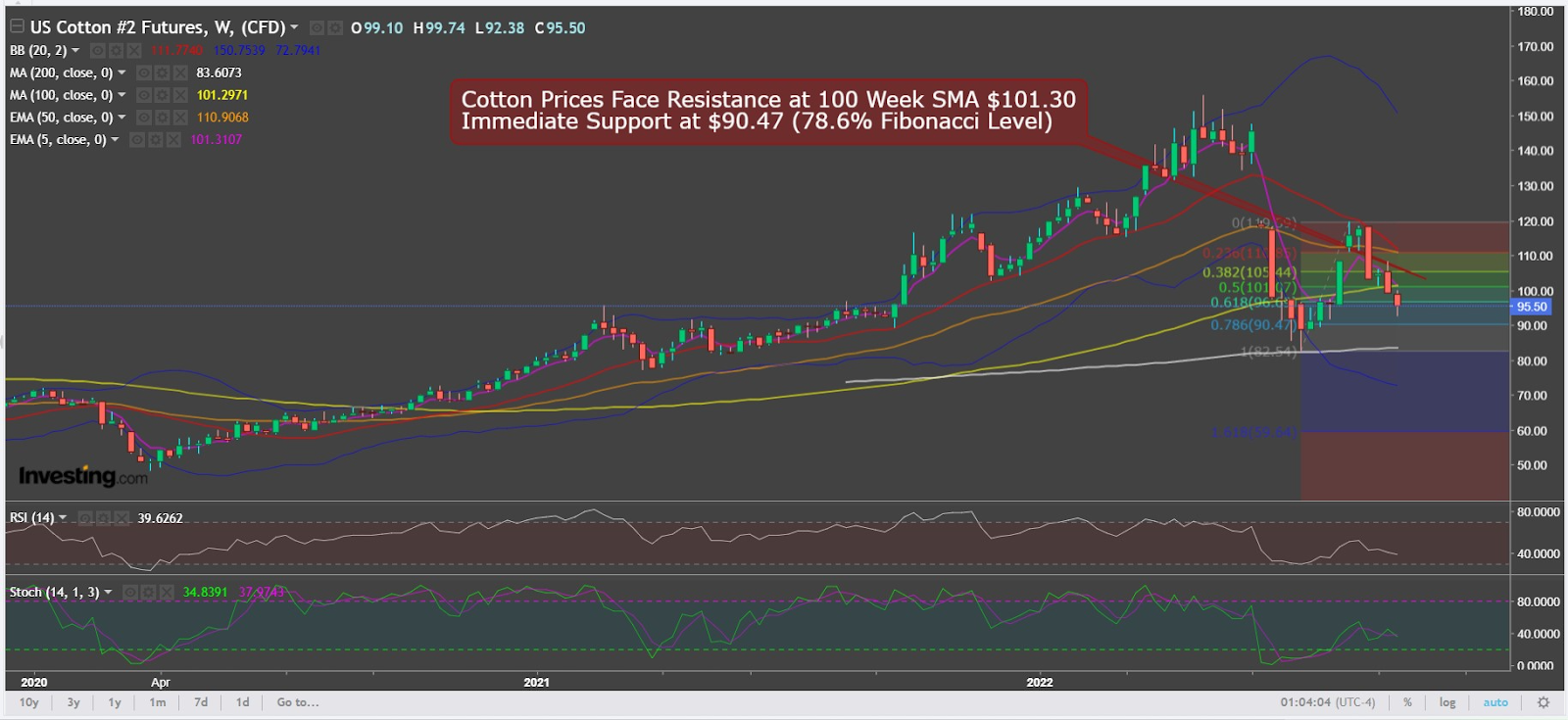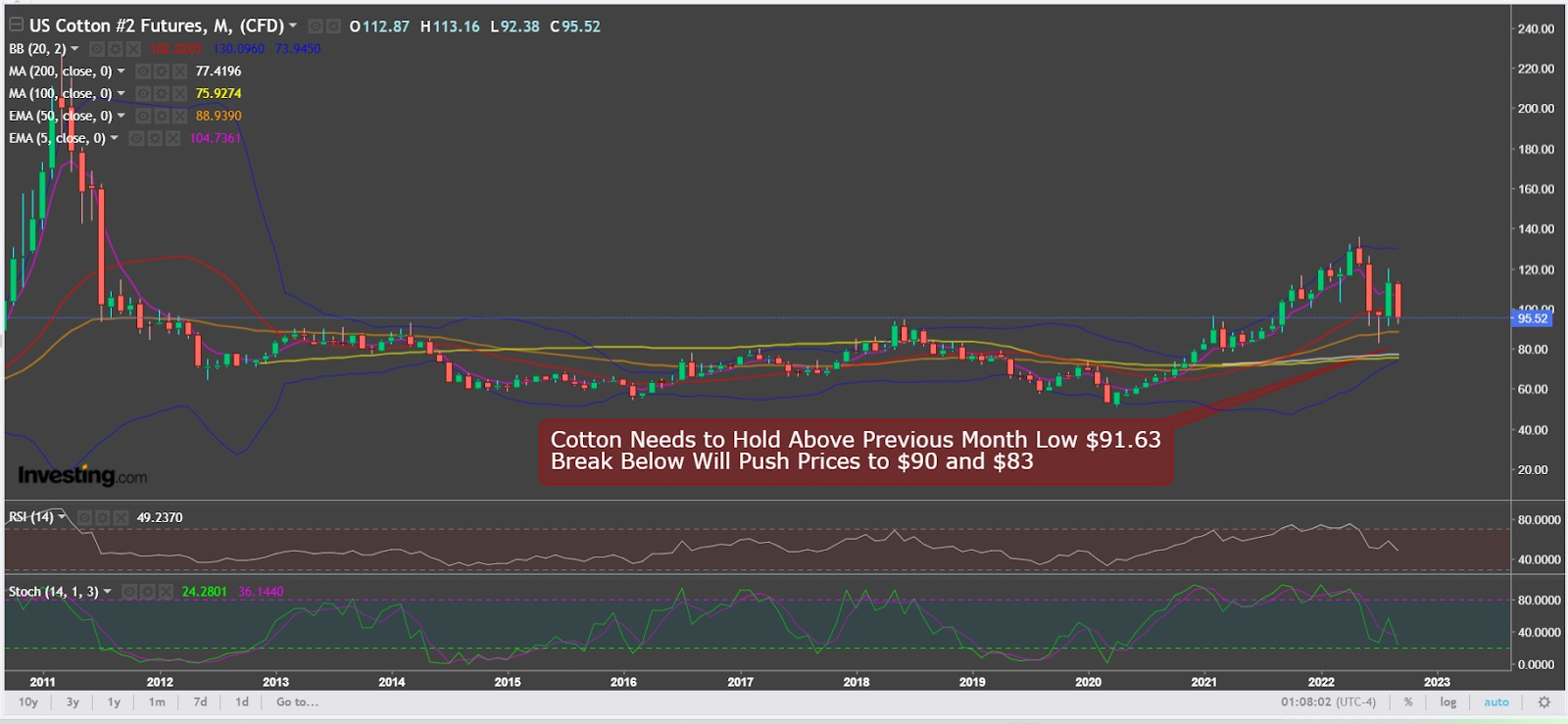- Cotton jumps 17% in August but then gives all back
- Charts suggest an immediate weakening back to July bottom of under 83 cents
- But cotton could also rebound to recapture highs of $1.1085
- Prices and demand aside, commodity faces one of its biggest crop challenges ever
After leaping 17% for its biggest rally in almost 12 years in August, cotton has given back all of those spectacular gains in less than a month, leaving bulls in the game wondering where the market is headed directionally.
Charts suggest a further weakening to July’s lows of beneath 83 cents per pound, which in itself was a 14-month bottom. Ahead of Friday’s US open, December, the front-month cotton contract on December delivery on ICE Futures US was below 96 cents. If the downside flagged by the chart signals is correct, it means cotton could lose another 13 cents, or almost 14%, before the bear streak is over.
The gloomy outlook isn’t helped by the Federal Reserve and other central banks’ recent rate hikes that are aimed at fighting inflation, but instead creating the fear of a global economic slowdown—which is anathema to a commodity like cotton.

Charts by SKCharting.com, with data powered by Investing.com
Cotton is one of the most vulnerable commodities in times of economic apprehension.
Usually when economists begin cautioning about a recession, one of the first impacts we see is a reduction in cotton consumption. The relationship is quite simple. When times are tough, clothing and furnishings become discretionary. People will put off buying new garments until times are better; corporations may delay refurbishments that include new rugs, drapes and fabric-based furniture.
All these make cotton more sensitive to an economic slowdown than any agricultural commodity, said Jack Scoville, chief crop analyst at Chicago’s Price Futures Group. He adds:
“Traders are worried about a global recession and demand in that recession. The trade is still worried about demand moving forward due to recession fears and Chinese lockdowns. It is also worried about total US production potential. It is possible that the continued Chinese lockdowns will continue to hurt demand for imported cotton in that country and that a weaker economy in the West will hurt demand from the rest of the world.”
For decades, cotton has been the foundation of many home and office furnishing products—sheets, towels, bedding, upholstery fabrics, and rugs, to name a few. That could change as the production crisis in the commodity worsens, said Warren Shoulberg, a furnishings industry academic who has taught at the Columbia University Graduate School of Business.
In a blog published two weeks ago, Shoulberg spelled out the perils that faced the global cotton crop:
“No matter where you look, cotton is in crisis. it’s quite likely that the 2022 cotton crop, whose harvest runs from now through November, could be as much as a third less than last year’s and one of the smallest outputs in recent memory.”
For good measure, he reminded those “who skipped Agriculture 101 in school [that] cotton is an annual crop, so any relief won’t be apparent until at least the fall of 2023.”

The crop statistics are indeed troubling.
In the United States, which is the third-largest grower of cotton and the largest exporter of the fiber, this year’s crop is likely to be significantly smaller due to drought in prime growing areas. The US Department of Agriculture has cut its forecast for 2022 cotton production by 28%, the lowest level in a decade. The worst-hit area is Texas, which accounts for more than half of the country’s output. Forecasts say that could be cut by half from last year, totaling more than $2 billion in cotton. A recent New York Times article reported that many Texas cotton growers aren’t even planning to harvest large swaths of their fields due to the meager crop they will yield.
Things could be even worse in Pakistan, the fifth-largest source of cotton. The problem there isn’t too little water, it’s too much. Recent storms have produced catastrophic flooding, and early estimates are that as much as one-half of the country’s crop was destroyed. Across the border in India, which is now the largest cotton grower in the world, flooding has also been a problem. A recent Quartz article found that “pests” have also destroyed crops this year, and the Cotton Association of India is estimating about a 6% to 8% fall in total cotton output amid reports that the country is now importing cotton.
In China, which had historically been the largest source of cotton for years but has now fallen to number two, excessive heat has been a challenge—similar to what Brazil has faced. But the real problem in China is more political than environmental, especially for the American market. The Biden administration has banned the use of cotton from the Xinjiang region of China, the source of as much as 20% of global cotton supplies—due to the alleged brutal treatment of the local Uyghur population by the Xi Jinping administration (the Chinese government denies the charges). It’s likely that products using cotton from the region are still ending up in American stores, but the restrictions are certainly adding to the global cotton squeeze.
In summation, Shoulberg wrote:
“A perfect ecological and political storm is emerging that threatens cotton’s dominance as the preeminent raw material for so many of these products. A one-two punch of seriously rising prices combined with severely limited supplies is already starting to impact the marketplace, but the full effect of these changes will not be apparent until 2023. And it will be at least 2024 before there’s any relief in sight.”
“The same environmental factors that are taking a human toll and devastating food crops around the world are also impacting cotton fields. The impending shortage of such an essential material, one that many of us have likely taken for granted, could upend the home furnishings business in new ways over the short and long-term.”
Notwithstanding the September rollback in prices after the July rally, Yahoo Finance reported that The World Bank still expected cotton to surge 40% on the year, and “the upward movement [thereafter] isn’t expected to stop anytime soon.”
By point of comparison, cotton was under 50 cents a pound at the start of the pandemic in the spring of 2020 and has generally traded in the 60 cents to 80 cents range for much of the past 10 years, according to the Trading Economics website. The relative spike, to above 90 cents per pound or even more than $1, could create demand destruction, some warn.
Many sheet and towel producers began switching their products from all cotton to cotton blends, and some to 100% polyester. The rise of so-called “microfiber” sheets—a great marketing name for a totally synthetic product that was inexpensive to make and often of an inferior quality—exploded, and even today, they account for a healthy share of sales in the marketplace.
The excessive cost of cotton also gave an advantage to other fibers, including cellulose-based ones like modal as well as wool, linen and even hemp, one that has persisted even as cotton prices returned more to historic levels.
In upholstered furniture fabrics, the cotton crisis of a decade ago coincided with the rise of performance fabrics that relied more on synthetic fibers. There’s no doubt that cotton-based coverings have lost market share in the furniture segment ever since. So far, suppliers of home textiles products say they are not yet abandoning cotton products.
But Shoulberg notes that demand for home furnishings continues to subside while inflation prices out some sheet and towel products.
“The industry will once again turn to alternative fibers. We can expect to see the larger impact of this as business in 2023 develops.”

So, what’s the imminent future looking like for ICE cotton pricing?
“There’s a lack of bullish resolve and shows reluctance to keep pace with previous month's rebound from July 82.62 lows,” said Sunil Kumar Dixit, chief technical strategist at SKCharting.com.
Dixit noted that the rebound that started from the July low saw a recovery to $1.1959 by mid-August, before the momentum faded to reach current levels of just below 95 cents.
“If cotton fails to hold above 91.63, prices are likely to drop to $90.47 which is a 78.6%-Fibonacci retracement of the 82.62 low and the $1.1959 high,” he said.
“If selling extends, expect a retest of $83 again.”
“But on the flip side, supportive consolidation above 92.47 should help cotton clear 96.69 and resume upside towards 1.0107, which is a 50% Fibonacci level. From here, it should extend the upward move towards $1.0544 and $1.1085 which correspond to 38.2% and 23.6% Fibonacci levels, respectively.”
Disclaimer: Barani Krishnan uses a range of views outside his own to bring diversity to his analysis of any market. For neutrality, he sometimes presents contrarian views and market variables. He does not hold a position in the commodities and securities he writes about.
